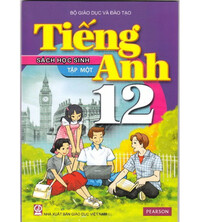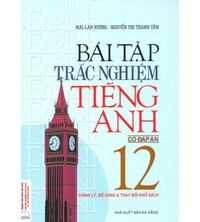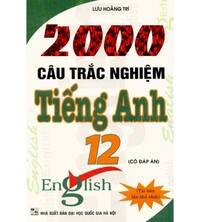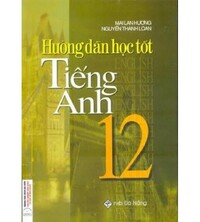Tiếng Anh 12 Unit 3 Review Unit 3
Read the text and choose the best answers (A-D). You will hear four speakers talking about mistakes they have made in a foreign language. Match sentences (A-E) with speakers (1-4). There is one extra sentence. The speaker...
Reading
Read the text and choose the best answers (A-D).
(Đọc đoạn văn và chọn câu trả lời đúng nhất (A-D).)
Mardi Gras: a party to remember
Mardi Gras. Two little words that describe a centuries-old celebration which originated in Medieval Europe. It is the name given to the final day of the Carnival season, the day that traditionally precedes forty days of fasting in some religions. The words mean 'Fat Tuesday, referring not only to the day on which the celebration is always held, but also to the custom of eating up all the forbidden food before the fast.
Today, it is the city of New Orleans in Louisiana, USA, that holds one of the most famous Mardi Gras celebrations in the world. Mardi Gras was introduced to North America in March 1699 by a French Canadian explorer called Jean-Baptiste Le Moyne de Bienville. Arriving on the eve of the festival at an area 90 kilometres south of what is now New Orleans, he organised the following day celebration on a plot of land he named Pointe du Mardi Gras. The custom soon caught on, and by the time New Orleans had been established by Bienville in 1718, Americans were celebrating their own version of Mardi Gras.
What makes the New Orleans event so special is its dazzling parades. Marching bands escort artistic carnival floats through streets lined with spectators wearing masks. These masks afforded the wearer a disguise which allowed him or her to mix with people of different classes.
As for the carnival floats, each one belongs to an organisation known as a 'krewe. The tradition of the 'krewe' began in 1856 when six young men from the nearby town of Mobile formed the 'Mistek Krewe of Comus. Not only does this group hold the distinction of being the first krewe, but it is also credited with parading the first float.
The second Mardi Gras krewe, the Twelfth Night Revelers was founded in 1870, and initiated another popular tradition, the Mardi Gras 'throws. These are small presents which are tossed to the crowd by the costumed float-riders. Mardi Gras was made official in New Orleans in 1875 when Governor Warmoth signed the Mardi Gras Act making Fat Tuesday a public holiday in Louisiana.
1 The first Mardi Gras was celebrated in North America when Bienville
A crossed the Canadian border.
B founded New Orleans.
C reached Pointe du Mardi Gras.
D landed on the coast of Louisiana.
2. Festival-goers started wearing masks at Mardi Gras because
A they were an obligatory part of the costume.
B they were made legal for the day.
C they were handed out by the float-riders.
D they hid a person's true identity.
3. 1856 is the year in which
A the first krewe was formed in New Orleans.
B floats began to take part in the parades.
C a committee was voted to organise the festival.
D the town of Mobile held its first Mardi Gras.
4. The Twelfth Night Revelers was the first krewe to
A pay for a float.
B dress up in colourful outfits.
C hand out money during a parade.
D provide gifts for spectators.
5. Before 1875,
A schools and offices were open during Mardi Gras.
B tourists were not welcome at the celebrations.
C krewes didn't have to pay for their own floats.
D Mardi Gras was financed by the governor.
Phương pháp giải:
Tạm dịch
Mardi Gras: bữa tiệc đáng nhớ
Mardi Gras. Hai từ nhỏ mô tả một lễ kỷ niệm hàng thế kỷ bắt nguồn từ Châu Âu thời Trung cổ. Đó là tên được đặt cho ngày cuối cùng của mùa Lễ hội, ngày theo truyền thống trước bốn mươi ngày ăn chay ở một số tôn giáo. Những từ này có nghĩa là 'Thứ Ba Béo', không chỉ đề cập đến ngày luôn tổ chức lễ kỷ niệm mà còn đề cập đến phong tục ăn hết đồ ăn bị cấm trước khi nhịn ăn.
Ngày nay, thành phố New Orleans ở Louisiana, Hoa Kỳ, là nơi tổ chức một trong những lễ kỷ niệm Mardi Gras nổi tiếng nhất thế giới. Mardi Gras được giới thiệu đến Bắc Mỹ vào tháng 3 năm 1699 bởi một nhà thám hiểm người Canada gốc Pháp tên là Jean-Baptiste Le Moyne de Bienville. Đến trước lễ hội tại một khu vực cách New Orleans ngày nay 90 km về phía nam, ông tổ chức lễ kỷ niệm vào ngày hôm sau trên mảnh đất mà ông đặt tên là Pointe du Mardi Gras. Phong tục này nhanh chóng được áp dụng và vào thời điểm New Orleans được Bienville thành lập vào năm 1718, người Mỹ đã tổ chức lễ kỷ niệm phiên bản Mardi Gras của riêng họ.
Điều khiến sự kiện New Orleans trở nên đặc biệt là những cuộc diễu hành rực rỡ. Các ban nhạc diễu hành hộ tống xe diễu hành lễ hội nghệ thuật qua các con phố với hàng dài khán giả đeo mặt nạ. Những chiếc mặt nạ này giúp người đeo cải trang để có thể hòa nhập với những người thuộc các tầng lớp khác nhau.
Đối với những chiếc xe diễu hành trong lễ hội, mỗi chiếc đều thuộc về một tổ chức được gọi là 'krewe'. Truyền thống của 'krewe' bắt đầu vào năm 1856 khi sáu thanh niên từ thị trấn Mobile gần đó thành lập 'Mistek Krewe of Comus. Nhóm này không chỉ nổi tiếng là krewe đầu tiên mà còn được ghi nhận là người đã diễu hành chiếc xe hoa đầu tiên.
Mardi Gras krewe thứ hai, Những người mặc khải đêm thứ mười hai được thành lập vào năm 1870 và khởi xướng một truyền thống phổ biến khác, lễ ném Mardi Gras. Đây là những món quà nhỏ được những người lái phao mặc trang phục hóa trang ném cho đám đông. Mardi Gras được chính thức tổ chức tại New Orleans vào năm 1875 khi Thống đốc Warmoth ký Đạo luật Mardi Gras biến Thứ Ba Béo thành ngày nghỉ lễ ở Louisiana.
Lời giải chi tiết:

1. D
The first Mardi Gras was celebrated in North America when Bienville
(Mardi Gras đầu tiên được tổ chức ở Bắc Mỹ khi Bienville)
A crossed the Canadian border.
(vượt qua biên giới Canada.)
B founded New Orleans.
(thành lập New Orleans.)
C reached Pointe du Mardi Gras.
(đến Pointe du Mardi Gras.)
D landed on the coast of Louisiana.
(đến bờ biển Louisiana.)
Thông tin: “Arriving on the eve of the festival at an area 90 kilometres south of what is now New Orleans, he organised the following day celebration on a plot of land he named Pointe du Mardi Gras.”
(Đến vào đêm trước lễ hội tại một khu vực cách New Orleans ngày nay 90 km về phía nam, anh ấy đã tổ chức lễ kỷ niệm vào ngày hôm sau trên mảnh đất mà anh ấy đặt tên là Pointe du Mardi Gras.)
2. D
Festival-goers started wearing masks at Mardi Gras because
(Những người tham gia lễ hội bắt đầu đeo mặt nạ tại Mardi Gras vì)
A they were an obligatory part of the costume.
(chúng là một phần bắt buộc của trang phục.)
B they were made legal for the day.
(chúng đã được coi là hợp pháp trong ngày đó.)
C they were handed out by the float-riders.
(chúng được trao bởi những người lái xe hoa.)
D they hid a person's true identity.
(họ che giấu danh tính thực sự của một người.)
Thông tin: “As for the carnival floats, each one belongs to an organisation known as a 'krewe.' These masks afforded the wearer a disguise which allowed him or her to mix with people of different classes.”
(Đối với những chiếc krewe trong lễ hội, mỗi chiếc đều thuộc về một tổ chức được gọi là 'krewe'. Những chiếc mặt nạ này giúp người đeo cải trang để có thể hòa nhập với những người thuộc các tầng lớp khác nhau.)
3. A
1856 is the year in which
(1856 là năm mà)
A the first krewe was formed in New Orleans.
(Krewe đầu tiên được thành lập ở New Orleans.)
B floats began to take part in the parades.
(Xe phao bắt đầu tham gia diễu hành.)
C a committee was voted to organise the festival.
(ủy ban đã được bầu chọn để tổ chức lễ hội.)
D the town of Mobile held its first Mardi Gras.
(thị trấn Mobile đã tổ chức Mardi Gras đầu tiên.)
Thông tin: “The tradition of the 'krewe' began in 1856 when six young men from the nearby town of Mobile formed the 'Mistek Krewe of Comus”
(Truyền thống của 'krewe' bắt đầu vào năm 1856 khi sáu thanh niên từ thị trấn Mobile gần đó thành lập 'Mistek Krewe of Comus')
4. D
The Twelfth Night Revelers was the first krewe to
(Những kẻ mặc khải đêm thứ mười hai là krewe đầu tiên)
A pay for a float.
(Trả tiền cho một chiếc phao.)
B dress up in colourful outfits.
(mặc trang phục đầy màu sắc.)
C hand out money during a parade.
(phát tiền trong một cuộc diễu hành.)
D provide gifts for spectators.
(tặng quà cho khán giả.)
Thông tin: “The second Mardi Gras krewe, the Twelfth Night Revelers was founded in 1870, and initiated another popular tradition, the Mardi Gras 'throws.' These are small presents which are tossed to the crowd by the costumed float-riders.”
(Mardi Gras krewe thứ hai, Những người mặc khải đêm thứ mười hai được thành lập vào năm 1870 và khởi xướng một truyền thống phổ biến khác, 'ném' Mardi Gras. Đây là những món quà nhỏ được những người lái xe hoa hóa trang ném cho đám đông.)
5. A
Before 1875,
(Trước năm 1875,)
A schools and offices were open during Mardi Gras.
(Trường học và văn phòng được mở trong suốt Mardi Gras.)
B tourists were not welcome at the celebrations.
(Khách du lịch không được chào đón tại lễ kỷ niệm.)
C krewes didn't have to pay for their own floats.
(krewes không phải trả tiền cho xe phao của mình.)
D Mardi Gras was financed by the governor.
(Mardi Gras được tài trợ bởi thống đốc.)
Thông tin: “Mardi Gras was made official in New Orleans in 1875 when Governor Warmoth signed the Mardi Gras Act making Fat Tuesday a public holiday in Louisiana”
(Mardi Gras được chính thức công bố ở New Orleans vào năm 1875 khi Thống đốc Warmoth ký Đạo luật Mardi Gras biến Thứ Ba Béo thành ngày nghỉ lễ ở Louisiana.)
Listening
You will hear four speakers talking about mistakes they have made in a foreign language. Match sentences (A-E) with speakers (1-4). There is one extra sentence. The speaker...
(Bạn sẽ nghe bốn diễn giả nói về những lỗi họ đã mắc phải bằng tiếng nước ngoài. Nối câu (A-E) với người nói (1-4). Có một câu bị thừa. Người nói...)
A used an inappropriate greeting.
B mispronounced a word.
C used the wrong verb.
D gave an incorrect response.
E misunderstood a word.
Speaker 1:
Speaker 2:
Speaking
Speaker 3:
Speaker 4:
Phương pháp giải:
*Nghĩa của các câu A-E
A used an inappropriate greeting.
(đã sử dụng một lời chào không phù hợp.)
B mispronounced a word.
(phát âm sai một từ.)
C used the wrong verb.
(dùng sai động từ.)
D gave an incorrect response.
(đã trả lời sai.)
E misunderstood a word.
(hiểu nhầm một từ.)
Speaking
Work in pairs. You and a friend are organising a surprise birthday party for another friend. Discuss the following points to make a plan for the party and come to an agreement.
(Làm việc theo cặp. Bạn và một người bạn đang tổ chức một bữa tiệc sinh nhật bất ngờ cho một người bạn khác. Hãy thảo luận những điểm sau đây để lập kế hoạch cho bữa tiệc và đi đến thống nhất.)
• Day (ngày)
• Guests (khách)
• Venue (địa điểm)
• Giftsn (quà)
Lời giải chi tiết:
Bài tham khảo
A: What day should we throw the fun party for our friend?
B: I think we should do it on the weekend before his birthday, so everyone can easily join without worrying about work schedules.
A: That's a good idea! How about next Saturday?
B: Sounds good, Saturday works well. Next, who should we invite?
A: I think we should invite our mutual friends and some members of his family. It'll be more enjoyable that way.
B: Agreed. I'll list down the most important people and invite them.
A: Regarding the venue, should we rent a place or host it at someone's house?
B: I think renting a small venue would be better to have more space for decorations and activities. What do you think?
A: Agreed. Renting a place would be better. Now, onto the issue of gifts. What do you think would make our friend happiest?
B: Perhaps we could collaborate and get a special gift together, or each of us could get a separate gift. What do you think?
A: I think collaborating and getting a special gift together would be great. We could brainstorm an interesting idea and purchase a larger gift together.
B: Sounds good! We'll work together to make a great gift for our friend.
Tạm dịch
A: Chúng ta nên tổ chức bữa tiệc vui vẻ cho bạn mình vào ngày nào?
B: Tôi nghĩ chúng ta nên tổ chức vào cuối tuần trước ngày sinh nhật của anh ấy, để mọi người có thể dễ dàng tham gia mà không cần lo lắng về lịch trình làm việc.
A: Đó là một ý tưởng hay! Thứ Bảy tới thì thế nào?
B: Nghe hay đấy, thứ Bảy hoạt động tốt. Tiếp theo, chúng ta nên mời ai?
A: Tôi nghĩ chúng ta nên mời bạn bè chung và một số thành viên trong gia đình anh ấy. Như vậy sẽ thú vị hơn.
B: Đồng ý. Tôi sẽ liệt kê những người quan trọng nhất và mời họ.
A: Về địa điểm, chúng ta nên thuê địa điểm hay tổ chức ở nhà ai đó?
B: Tôi nghĩ thuê một địa điểm nhỏ sẽ tốt hơn để có nhiều không gian trang trí và hoạt động hơn. Bạn nghĩ sao?
A: Đồng ý. Thuê một nơi sẽ tốt hơn. Bây giờ chuyển sang vấn đề quà tặng. Bạn nghĩ điều gì sẽ làm bạn của chúng ta hạnh phúc nhất?
B: Có lẽ chúng ta có thể hợp tác và cùng nhau nhận được một món quà đặc biệt, hoặc mỗi người chúng ta có thể có được một món quà riêng. Bạn nghĩ sao?
A: Tôi nghĩ việc hợp tác và cùng nhau nhận được một món quà đặc biệt sẽ rất tuyệt. Chúng ta có thể nghĩ ra một ý tưởng thú vị và cùng nhau mua một món quà lớn hơn.
B: Nghe hay đấy! Chúng ta sẽ làm việc cùng nhau để tạo ra một món quà tuyệt vời cho người bạn của chúng ta.
Writing
Some students choose to go backpacking in the holidays. Is this a good idea? Write an essay (180-200 words) in which you express your opinion considering the impact of this kind of holiday on the students and on the countries they visit.
(Một số sinh viên chọn đi du lịch bụi vào dịp nghỉ lễ. Đây có phải là một ý tưởng tốt? Viết một bài luận (180-200 từ) trong đó bạn bày tỏ quan điểm của mình về tác động của loại kỳ nghỉ này đối với sinh viên và các quốc gia họ đến thăm.)
Lời giải chi tiết:
Bài tham khảo
Among the various forms of travel, backpacking stands out as a particularly adventurous and immersive way to discover the world. However, while the allure of backpacking during holidays is undeniable, it's crucial to consider its impact, both on the students undertaking the journey and on the countries they visit.
Backpacking during holidays can have a profound impact on students, Firstly, it provides them with a valuable opportunity for personal growth and development. Traveling independently requires students to step out of their comfort zones, navigate unfamiliar territories, and overcome unexpected challenges. These experiences not only foster resilience and self-reliance but also instill crucial life skills such as problem-solving, decision-making, and adaptability. Moreover, backpacking promotes cultural exchange and understanding.
Furthermore, backpacking can have a significant impact on the countries students visit. On one hand, responsible backpacking can contribute positively to local economies and communities. Additionally, cultural exchange between backpackers and locals can promote mutual understanding, break down stereotypes, and build bridges between different cultures.
In conclusion, while backpacking during holidays offers students unparalleled opportunities for personal growth, cultural enrichment, and global engagement, it's essential to approach it responsibly and mindfully. By fostering intercultural understanding, supporting local communities, and practicing sustainable tourism, students can ensure that their backpacking adventures leave a positive impact, both on themselves and on the countries they visit.
Tạm dịch
Trong số các hình thức du lịch khác nhau, du lịch bụi nổi bật như một cách đặc biệt mạo hiểm và hấp dẫn để khám phá thế giới. Tuy nhiên, mặc dù sức hấp dẫn của việc du lịch bụi trong kỳ nghỉ là không thể phủ nhận, nhưng điều quan trọng là phải xem xét tác động của nó đối với cả sinh viên thực hiện hành trình và quốc gia họ ghé thăm.
Du lịch bụi trong kỳ nghỉ có thể có tác động sâu sắc đến học sinh. Thứ nhất, nó mang lại cho họ cơ hội quý giá để trưởng thành và phát triển cá nhân. Du lịch độc lập đòi hỏi học sinh phải bước ra khỏi vùng an toàn của mình, khám phá những vùng đất xa lạ và vượt qua những thử thách bất ngờ. Những trải nghiệm này không chỉ thúc đẩy khả năng phục hồi và tự lực mà còn thấm nhuần các kỹ năng sống quan trọng như giải quyết vấn đề, ra quyết định và khả năng thích ứng. Hơn nữa, du lịch bụi thúc đẩy trao đổi văn hóa và hiểu biết.
Hơn nữa, du lịch bụi có thể có tác động đáng kể đến các quốc gia mà sinh viên ghé thăm. Một mặt, du lịch bụi có trách nhiệm có thể đóng góp tích cực cho nền kinh tế và cộng đồng địa phương. Ngoài ra, trao đổi văn hóa giữa du khách ba lô và người dân địa phương có thể thúc đẩy sự hiểu biết lẫn nhau, phá bỏ khuôn mẫu và xây dựng cầu nối giữa các nền văn hóa khác nhau.
Tóm lại, mặc dù du lịch bụi trong kỳ nghỉ mang lại cho học sinh những cơ hội tuyệt vời để phát triển cá nhân, làm giàu văn hóa và gắn kết toàn cầu, nhưng điều cần thiết là phải tiếp cận nó một cách có trách nhiệm và có tâm. Bằng cách thúc đẩy sự hiểu biết liên văn hóa, hỗ trợ cộng đồng địa phương và thực hành du lịch bền vững, sinh viên có thể đảm bảo rằng chuyến phiêu lưu du lịch bụi của họ để lại tác động tích cực cho cả bản thân họ và quốc gia họ đến thăm.
Search google: "từ khóa + timdapan.com" Ví dụ: "Tiếng Anh 12 Unit 3 Review Unit 3 timdapan.com"







